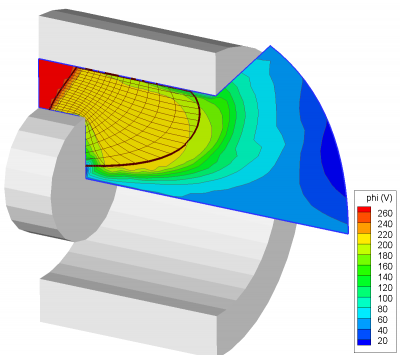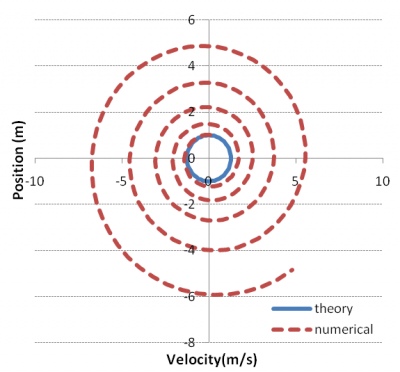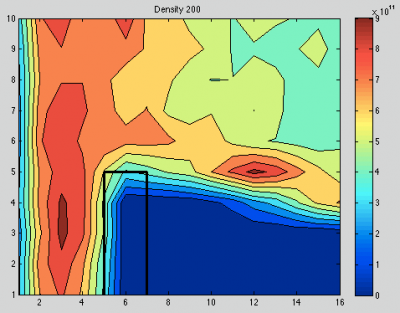Plasma Physics and Scientific Computing Blog
Our blog features regular articles on numerical methods for plasma and rarefied gas simulations, as well as general updates related to plasma propulsion and spacecraft contamination control. Subscribe to the newsletter to avoid missing any articles.
-
Filter by category:
- Apps
- Contamination
- Embedded Systems
- Field Solvers
- Interactive
- Mesh Generation
- News
- Numerical Methods
- Papers and Codes
- Plasma Simulation
- Starfish
- Surface Interactions
- Uncategorized
- Visualization
Charge Exchange Collisions (CEX)

Charge exchange is an important reaction occurring in the plumes of electric propulsion devices. In this reaction, an ion and neutral come into a close contact and exchange an electron without any corresponding change in the momentum of the two particles. In the EP plumes this results in the formation of slow moving ions near the thruster exit. These ions are then accelerated radially out of the plume into areas with no line of sight to the thruster. (Nov 16 2011)
HTML5 for Scientific Computing

HTML5 is the new standard for writing webpages. It introduces several new powerful capabilities, such as embedded video and drag and drop. It also introduces a new tag called canvas that allows us to do real time graphing and visualization using Javascript. In this example we show you how to plot XY graphs using Javascript and HTML5. (Oct 28 2011)
Multiscale Modeling of Hall Thrusters

One of the topics we specialize in at Particle In Cell Consulting is modeling of electric propulsion (EP) thrusters. These devices generate thrust by accelerating ionized propellant (plasma). One of the most efficient EP devices is the Hall thruster. These devices have been flown for over 40 years, however, much still remains unknown about the details of their operation. (Aug 24 2011)
2013 IEPC at GWU

The International Electric Propulsion Conference (IEPC) is the premier international conference for researches studying electric propulsion (plasma) rockets. The 2011 conference took place in Wiesbaden, Germany. The next conference will take place in 2013 at the George Washington University in Washington, D.C. Particle In Cell Consulting will be helping to make this a great event. See you there? (Jul 31 2011)
Particle Push in Magnetic Field (Boris Method)

A follow up on the previous article, in this tutorial we show you how to integrate the particle motion in the presence of a magnetic field. Inclusion of the magnetic field makes the integration an implicit problem, and care needs to be taken to conserve energy. A simple forward differencing would result in a non-physical energy gain, and the particle would spiral away from the guiding center. (Jul 11 2011)
Leapfrog Particle Push (Velocity Integration)

In this article we discuss probably the most fundamental aspect of numerical simulations with the particle in cell (PIC) method: pushing particles. We introduce the commonly used leapfrog method, and provide a simple numerical algorithm in the form of an Excel spreadsheet that implements this method. (Jul 10 2011)
Get results faster with Java multithreading

Code parallelization is the process of modifying a simulation program so that it can take advantage of multiple computational cores to obtain results faster. One method is to distribute the workload locally in the form of computational threads. Java makes it easy to add multithreading to your code. Here we show you how to implement a "poor-man's" method, in which individual cases run serially, but multiple cases are launched concurrently. (Jun 25 2011)
Spacecraft Surface Charging

A spacecraft acts as an isolated probe and will become charged due to the presence of space plasma. Surface potential will change due to the thermal motion of electrons and ions. The potential will continue to change until the fluxes of the negative and positive charges perfectly balance each other. In this article we discuss the basics behind spacecraft charging and provide a simple spacecraft charging code example. (May 10 2011)
The Finite Volume Method

The Finite Volume Method (FVM) is an algorithm for solving differential equations. It is based on the integral formulation of the problem, with each computational element corresponding to a volume over which the integration is performed. It is somewhat more complex than the Finite Difference, however, it can be applied to arbitrarily shaped domains. In this article we show you the basics of this method and provide a simple solver. (Apr 19 2011)
The Finite Difference Method

Numerical simulations generally involve solving some differential equations on a computational domain too complicated to solve analytically. The Finite Difference (FD) is a method for solving differential equations. It is a very popular method since it is very easy to understand and implement. Here we introduce the basics of this method and provide a simple example. (Mar 1 2011)
The Electrostatic Particle In Cell (ES-PIC) Method

Particle In Cell (PIC) is the name of a method used to numerically model dynamics of ionized gases, or plasmas. Its name stems from the fact that the gas is represented by a large number of computational particles that move in a disretized domain. The mesh cells are used to determine the global interactions between the charged particles. In this tutorial we show you how to implement the PIC method and provide a simple Matlab PIC code. (Nov 8 2010)